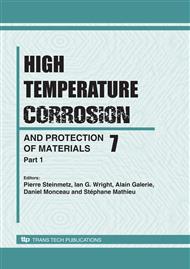p.797
p.805
p.813
p.823
p.833
p.841
p.851
p.861
p.871
Investigation of the Development Processes of Self-Organizing, Protective Oxide Scales and Wear Resistant Surface Layers on the Fe-44%Cr-1%Ni-4%Al-0.3%La Alloy
Abstract:
Using the methods of scanning electron microscopy (SEM), Auger electron spectrometry (AES), fast electron diffraction (FED) in the “on reflection” regime and wavelength dispersive spectrometry (WDS) a complex investigation of the hierarchical sequence of amorphous Beilby layer formation has been studied due to the self-organizing dissipative processes, associated with extensive cold work, on the surface of an Fe-Cr-Ni-Al-La alloy, with high (>40%) chromium content. It was established that, the surface layer (≤1μm thickness) of the mechanically polished specimen of Fe-44%Cr-1%Ni-4%Al-0.3%La alloy consists of the amorphous Beilby layer and that its adjacent matrix layer, crushed due to the plastic deformation, formed an entropy “excited” functional system, which at the temperature of 1200°C in laboratory atmosphere permits the formation of an oxide surface layer with a micro-wrinkles modulated structure of uniform thickness, in the form of mixture of nanocrystallites (100÷500nm) made of oxides of atoms constituting the basic metallic matrix. Beneath this layer a thin alumina scale is observed to form. Increasing the oxidation temperature causes the regrowth of nanocrystallites and also the recrystallization processes, accompanied by solid-phase reactions between oxide nano-particles. This leads to scale delamination at the superficial oxide thin uniform alumina layer interface. The Al2O3 layer is characterized by high adherence with metallic substrate and provides protective features against both high temperature (1200°C) oxidation of the matrix and resistance to abrasion. By the pretreatment at 1200°C of the investigated alloy’s surface modified specimens, there forms a low thickness (several microns) scale which has ultra fine graininess (~1μ) with no porosity and blocked grain boundaries short-circuit diffusion paths. This gives to the scale the ability to protect the metallic matrix against high temperature gas (and other aggressive environment) corrosion.
Info:
Periodical:
Pages:
833-840
Citation:
Online since:
September 2008
Authors:
Price:
Сopyright:
© 2008 Trans Tech Publications Ltd. All Rights Reserved
Share:
Citation:


